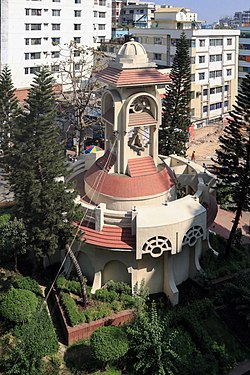Cheragi Pahar চেরাগী পাহাড় | |
|---|---|
Historical place | |
 Cheragi Pahar Circle | |
| Nicknames: Cheragi More, Cheragi Square | |
| Coordinates: 22°20′37″N91°50′01″E / 22.34367°N 91.83368°E | |
| Country | Bangladesh |
| District | Chittagong |
| Place | Cheragi Pahar |
| Government | |
| • Type | Mayor–council |
| • Mayor | Khorshed Alam Sujon (City Administrator) |
| • City Mayor | Chittagong City Corporation |
| Demonym | Chittagonian |
| Time zone | UTC+06:00 (BST) |
| BTCL | 031 |
Cheragi Pahar (sometimes written Cheragee Pahar) [1] is a cultural and historical place located at Chittagong, Bangladesh. [2] [3] Most of the cultural activities of Chittagong and related business were established in the place. Some parts of the region Momin Road are the part of Cheragee Pahar Circle.





